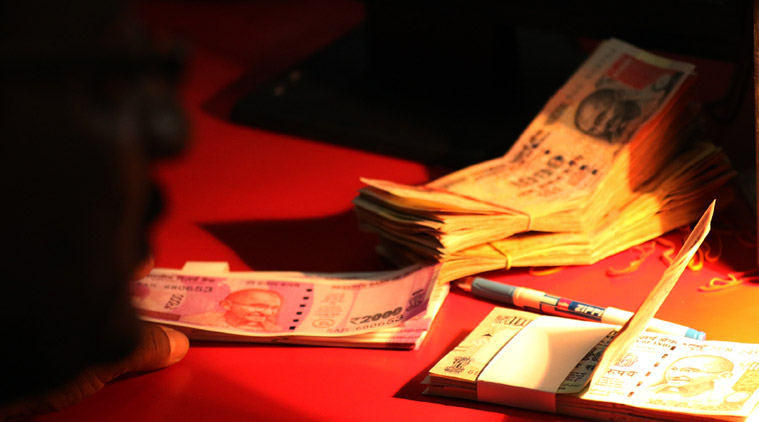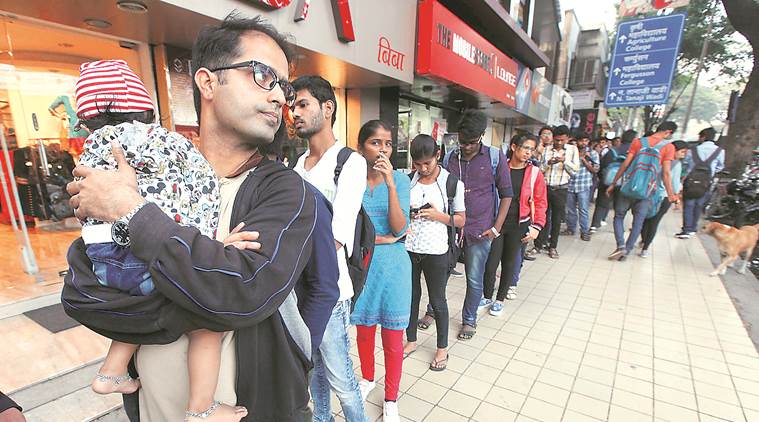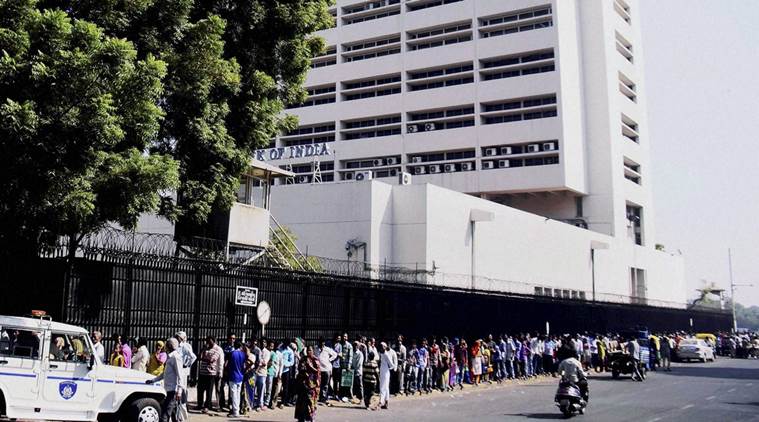100 days of demonetisation: Bank queues, RBI flip-flops – here is how it all unfolded
By the end 100-day mark, the situation has stabilised by some measure, but the shock is still felt and will take some time to wither away.

Hundred days have passed since Prime Minister Narendra Modi-led Central government announced its demonetisation drive. The government invalidated legal tender of ₹500 and ₹1,000 and announced restrictions on ATM and bank withdrawals on November 8. Further announcements included introduction of new currency notes of ₹500 and ₹ 2,000 denomination. Announcing the decision, PM Modi had asked for 50 days to bring the situation back to normal. At the end of 50 days on December 30, the RBI and the Centre had both come out with a combined 74 notifications, circulars, decisions and reviews or turnarounds of those decisions. By the end 100-day mark, the situation has stabilised by some measure, but the shock is still felt and will take some time to wither away.
After the November 8 announcement, a deadline was announced to deposit old demonetised currency in banks. Penalties were announced on unaccounted wealth and many people, some even bank employees, were found laundering dirty money for their clients. Raids were carried out to trace out illicit wealth, people were encouraged, even forced at times, to move to digital payments. Hundreds of millions of people stood in line to deposit or withdraw currency at banks and often out of order ATMs, economists cried foul and people were left with a promise that this is short term pain for long term good.
Many lost their lives standing in queues and farmers were forced to sell their produce at throwaway prices. Digital payment infrastructure crumbled with high demand and low preparation. Digital India was not there to support demonetisation blues. After demonetising 86 per cent of the currency on November 8, only 0.0006% was recovered as counterfeit. Although large amounts of money made its way into the banking system, citizens by and large suffered the brunt.
Here is a recap of 100 days of demonetisation
How things stand:
After countless changes in regulations, the weekly transaction limits at banks for savings account is ₹24,000. This will be raised to ₹50,000 from February 20. As a final relief, the limit will be completely lifted for savings accounts from March 13 this year. Cash withdrawal limits at ATMs have been lifted and all limits on cash withdrawals for current accounts stand lifted.
Banks must report accounts with aggregate deposits over ₹10 lakh a year and also credit card bill payments done in cash of ₹1 lakh or more. Banks still have to report all deposits aggregating worth ₹2.5 lakh or above in any person’s accounts between November 9 and 30 December 2016.
Although the deadline to deposit demonetised currency notes was December 30, people can still exchange old demonetised notes for legal currency notes till 31 March at select RBI offices that will be eligible for scrutiny.
The government’s Specified Bank Notes Cessation of Liabilities Ordinance has made holding of more than 10 junked Rs 500 and Rs 1,000 currency notes a penal offence punishable with a minimum Rs 10,000 fine. Non-KYC verified payment limit on e-wallets are at ₹20,000 from the previous 10,000. Merchants allowed transfer from e-wallets to linked bank accounts up to ₹50,000 a month. There are no limits on a transaction. APMC registered traders in mandis may withdraw ₹50,000 a week from current accounts.
Farmers allowed a 2-month grace period to pay crop loans and they were granted a 3% interest subvention. Farmers can now also withdraw ₹25,000 a week from loan/deposit accounts.
Here is a timeline of how demonetisation was announced:
November 8: Demonetisation announced. November 9 announced non-business working day for banks. All banks, ATMs, cash deposit machines stayed shut on November 9 and 10. ATM cash withdrawal limit pegged at ₹2,000 a day per card till November 18. From November 19, limits supposed to increase to ₹4,000 a day.
Grace period announced for persons unable to deposit or exchange specified bank notes on or before the December 30 deadline at specified RBI offices till a later date. RBI notified ATMs to be recalibrated in two days and opened for public on November 11 to dispense ₹50 and ₹100 notes. However, the previous never materialised and the ₹ 100 notes later found their way into ATMs after much hue and cry from the public as ATMs were only loaded with ₹2,000 notes for weeks on end.
November 9: Banks, ATMs and other services were supposedly recalibrated but to no avail. RBI announced banks will work on Saturday Nov 12, and Sunday, Nov 13. Government announced Specified Bank Notes (SBN) denoting demonetised currency of ₹500 and ₹2,000 would remain legal tender till November 11 for transactions at government hospitals, pharmacies and grocery stores. Transactions were allowed at international airports for passengers up to ₹5,000; Foreign tourists allowed to exchange forex or SBNs up to ₹5,000.
November 10: Over the counter cash withdrawal limit at banks set a ₹10,000 a day with a weekly limit of ₹ 20,000 a week till November 24. Government departments were given flexibility on this limit given they justify their need for extra cash in writing. The day the government allowed
November 13: Limit for exchange of notes was raised from ₹4,000 a day to ₹4,500 a day. Also, daily ATM withdrawal limits raised to ₹2,500 per card. Rs 2,000 to Rs 2,500. Weekly limit up to ₹ 24,000 from ₹ 20,000. Centre announces it has already started issuing new series of ₹500 notes.
November 14: Current account withdrawal limits up to ₹50,000 a week. Banks may deploy micro ATMs near village panchayat offices, police stations and military outposts, and govt depts, etc. Proposed waiver of levy on ATM charges for savings accounts customers.
November 15: Controversial decision announced for putting indelible ink mark on right index finger of a customer to identify that he/she has exchanged old notes only once.
November 16: Mandatory for people depositing cash over ₹50,000 to submit PAN details at banks.
November 17: Over the counter exchange limit pegged at ₹2,000 from November 18. This facility was also only to be availed by a person once. Meanwhile, Central government employees were given the option to withdraw ₹10,000 advance salary in cash. Government provided micro ATMs at government offices for the same.

November 18: Withdrawal limit at point of sale PoS set at ₹2,000 a day at all merchant establishments.
November 21: Government announced higher cash withdrawals for weddings at a maximum limit of ₹2,50,000 per family till December 30. However, during wedding season, the restrictions caused massive loss to merchants and vendors along with huge difficulties for families trying to pay vendors for weddings, not to mention dropping numerous rituals due to shortage of cash. Farmers also allowed to purchase seeds for their crop using old ₹500 notes.
November 22: First notifications by RBI to incentivise e-payments. Banks advised to keep cash available for Rabi crop sowing season. NABARD to utilise own cash credit limits up to ₹23,000 in order to enable DCCBs to disburse crop loans to farmers. RBI acknowledges some bank officials are indulging in fraudulent practices whiles accepting/exchanging SBN deposits. Enhanced vigilance advised and stern action and penalties announced. In the next few days, a series of raids were carried out at public and private banks where bank employees were found to be helping their clients launder their black money via fake accounts.
November 23: Banks told to not accept SBNs in small savings schemes. Centre finds thousands of Jan Dhan Accounts see surge of deposits in few weeks.
November 24: Over-the-counter exchange of SBNs not allowed after November 24 going against the earlier deadline provided of December 30.
November 28: Declarant of unaccounted wealth may have to pay 49% tax and 25% of his money would be stored in a zero interest account for a period of four years.
November 29: Government pushes digital payments and to increase the number of POS machines and decrease their purchase cost, POS machines were exempted from Central Excise duty.
November 30: Jan Dhan Account holders with full KYC verification to be allowed ₹10,000 withdrawal from the account in a month. Limited or Non-KYC-compliant PMJDY account holders allowed Rs 5,000 a month
December 1: Government clarifies tax department to not seize jewellery/ornaments of up to 500 grams from a married lady, up to 250 grams from an unmarried lady and up to 100 grams from a male even if the assets don’t match with the holder’s income.
December 16: Rationalisation of customer charges for IMPS, UPI and USSD announced and all participating banks directed to not levy any charges on customers transactions up to ₹1,000 on IMPS and UPI systems effective from January 1, 2017 and applicable till March 31, 2017. For transactions up to Rs 1,000, merchant discount rate (MDR) was capped at 0.25%. For transactions above ₹1,000 and up to ₹2,000, MDR was capped at 0.5%.
December 19: In another controversial decision, government announced deposits over ₹5,000 into a bank account to be done only once till December 30 and banks told accept deposits after only after the depositor is questioned by at least two bank officials regarding the reason for deposits so near the deadline and not earlier.
December 21: RBI withdraws the restriction of one time deposit of SBNs over ₹5,000 after December 21.
December 29: Banks advised to provide ‘additional working capital limit’ to their MSE borrowers
December 30: Closure of the scheme of exchange of SBNs at banks. All banks to report information on collection of SBNs on Dec 30 itself in email. All bank branches (other than those of DCCBs) were directed to deposit the accumulated SBNs at issue offices of the RBI or at a currency chest on Dec 31.
Further, the RBI clarified announced that Indian living overseas will get a grace period till March 31 to deposit demonetised notes and non-resident Indians will get time till June 30.
The Indian Express Online Media Pvt Ltdm
n


 While this structure will apply to voluntary disclosures, a higher rate of tax and penalty of total 90 per cent tax will be imposed on those who do not disclose their unaccounted cash deposits voluntarily.
While this structure will apply to voluntary disclosures, a higher rate of tax and penalty of total 90 per cent tax will be imposed on those who do not disclose their unaccounted cash deposits voluntarily. A man with a baby lines up to withdraw cash at a bank on Pune’s FC Road. (Photo: Pavan Khengre)
A man with a baby lines up to withdraw cash at a bank on Pune’s FC Road. (Photo: Pavan Khengre) A large queue of people wait outside a bank to exchange invalidated notes of Rs.1000 and Rs.500. (Source: AP)
A large queue of people wait outside a bank to exchange invalidated notes of Rs.1000 and Rs.500. (Source: AP) People line up outside RBI’s Ahmedabad branch to exchange old currency.
People line up outside RBI’s Ahmedabad branch to exchange old currency.




 →
→











0 comments:
Post a Comment